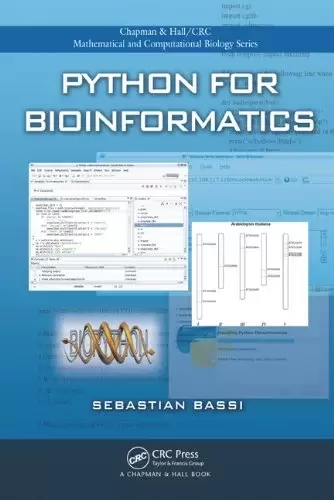
Book Description
Programming knowledge is often necessary for finding a solution to a biological problem. Based on the author’s experience working for an agricultural biotechnology company, Python for Bioinformatics helps scientists solve their biological problems by helping them understand the basics of programming. Requiring no prior knowledge of programming-related concepts, the book focuses on the easy-to-use, yet powerful, Python computer language.
The book begins with a very basic introduction that teaches the principles of programming. It then introduces the Biopython package, which can be useful in solving life science problems. The next section covers sophisticated tools for bioinformatics, including relational database management systems and XML. The last part illustrates applications with source code, such as sequence manipulation, filtering vector contamination, calculating DNA melting temperature, parsing a genbank file, inferring splicing sites, and more. The appendices provide a wealth of supplementary information, including instructions for installing Python and Biopython and a Python language and style guide.
By incorporating examples in biology as well as code fragments throughout, the author places a special emphasis on practice, encouraging readers to experiment with the code. He shows how to use Python and the Biopython package for building web applications, genomic annotation, data manipulation, and countless other applications.
Table of Contents
Part I: Programming
Chapter 1: Introduction
Chapter 2: First Steps with Python
Chapter 3: Basic Programming: Data Types
Chapter 4: Programming: Flow Control
Chapter 5: Dealing with Files
Chapter 6: Code Modularizing
Chapter 7: Error Handling
Chapter 8: Introduction to Object Orienting Programming (OOP)
Chapter 9: Regular Expressions
Part II: Biopython
Chapter 10: Introduction to Biopython
Part III: Advanced Topics
Chapter 11: Web Applications
Chapter 12: XML
Chapter 13: Python and Databases
Chapter 14: Collaborative Development: Version Control
Part IV: Python Recipes with Commented Source Code
Chapter 15: Sequence Manipulation in Batch
Chapter 16: Web Application for Filtering Vector Contamination
Chapter 17: Searching for PCR Primers Using Primer3
Chapter 18: Calculating Melting Temperature from a Set of Primers
Chapter 19: Filtering Out Specific Fields from a Genbank File
Chapter 20: Converting XML BLAST File into HTML
Chapter 21: Infering Splicing Sites
Chapter 22: DNA Mutations with Restrictions
Chapter 23: Web Server for Multiple Alignment
Chapter 24: Drawing Marker Positions Using Data Stored in a Database
Appendix A: Python and Biopython Installation
Appendix B: Selected Papers
Appendix C: Included DVD: Virtual Machine Installation and Use
Appendix D: Python Language Reference
Appendix E: Answers to Odd-Numbered Questions
Appendix F: Python Style Guide
中文:
书名:Python for Bioinformatics
编程知识对于寻找生物学问题的解决方案通常是必要的。根据笔者在一家农业生物技术公司工作的经验, Python for Bioinformatics 通过帮助科学家了解编程基础知识来帮助他们解决生物学问题。这本书不需要编程相关概念的先验知识,而是专注于易于使用但功能强大的Python计算机语言。
这本书以非常基本的介绍开始,教授编程原则。然后介绍了Biopython包,它可以用来解决生命科学问题。下一节将介绍生物信息学的复杂工具,包括关系数据库管理系统和XML。最后一部分用源代码说明了应用程序,如序列操作、过滤载体污染、计算DNA熔化温度、解析GenBank文件、推断剪接位点等。附录提供了丰富的补充信息,包括安装Python和Biopython的说明以及一本Python语言和样式指南。
通过结合生物学中的例子和贯穿始终的代码片段,作者特别强调实践,鼓励读者试验代码。他展示了如何使用Python和Biopython包来构建Web应用程序、基因组注释、数据操作以及无数其他应用程序。
Table of Contents
Part I: Programming
Chapter 1: Introduction
第2章:使用Python的第一步
第3章:基本编程:数据类型
第4章:编程:流量控制
第5章:处理文件
第6章:代码模块化
Chapter 7: Error Handling
第8章:面向对象编程(OOP)简介
第9章:正则表达式
Part II: Biopython
第十章:Biopython简介
Part III: Advanced Topics
第11章:Web应用程序
Chapter 12: XML
第13章:Python和数据库
第14章:协作开发:版本控制
第四部分:带有注释源代码的Python食谱
第15章:批处理中的序列操作
第16章:用于过滤媒介污染的Web应用程序
第17章:使用Primer3搜索聚合酶链式反应
第18章:根据一组底漆计算熔化温度
第19章:从Genbank文件中筛选出特定字段
第20章:将XML BLAST文件转换为HTML
第21章:推断剪接位点
第22章:有限制的DNA突变
Chapter 23: Web Server for Multiple Alignment
第24章:使用存储在数据库中的数据绘制标记位置
附录A:安装Python和Biopython
附录B:论文选集
附录C:随附的DVD:虚拟机安装和使用
Appendix D: Python Language Reference
附录E:奇数问题的答案
附录F:《Python样式指南》
评论前必须登录!
注册